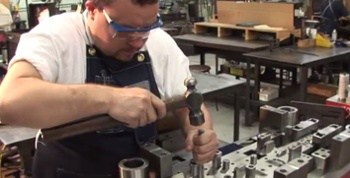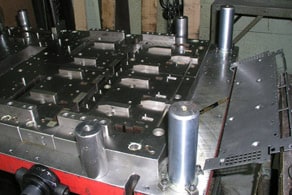Hog Butcher for the World,
Tool Maker, Stacker of Wheat,
Player with Railroads and the Nation’s Freight Handler.
Carl Sandburg
For nearly six decades, Manor Tool and Manufacturing Company has been providing our hometown of Chicago with the finest metal stamping services in the Midwest. We’re proud to be regarded as a pillar of the city’s manufacturing industry, and we look forward to promoting industry in Chicago for years to come.
Chicago has long been founded on heavy industry. Since its founding as a small trading post at the foot of Lake Michigan, the city has evolved into one of the world’s industrial powerhouses. Even today, Chicago’s manufacturers remain essential to the American economy, supplying the country with everything from construction equipment to medical devices. As proud Chicagoans ourselves, we wanted to take a moment to walk through the history of manufacturing in our city and the metal stamping that underlies so much of it.
The Early Years
Chicago became a center of American industry in large part because of its location. Thanks to the portage between the Chicago and Des PlainesRivers, Chicago connected the Great Lakes with the Mississippi River and its many tributaries, effectively providing access to the entire interior of North America before railroads connected it to the rest of the country.
The young United States recognized Chicago’s importance early in its history, with American settlers first arriving in the area in the early nineteenth century. Agriculture soon followed, along with the first iron foundry in the state of Illinois.
1830s: A Center of Running Waters
The completion of the Erie Canal in 1825 transformed Chicago. By connecting the Hudson River to the Great Lakes, it created a direct water route between the major ports of the east with the rapidly growing Midwest. The Chicago Portage offered the Canal’s users direct access to the heartland and Chicago soon became the primary destination for the country’s grain, iron, and produce.
Because it still necessitated some overland travel, however, the Portage was not perfect. To further simplify transportation between the Great Lakes and the Mississippi, Chicago began construction of the Illinois and Michigan Canal in 1836. With its completion in 1848, the city effectively controlled all traffic between the Great Lakes and the Mississippi, making it the center of American transportation.
1850s: The Rise of the Railroads
The coming of the railroads ensured that Chicago would continue to command a powerful influence over American transportation. Major railroads from the East Coast terminated in Chicago, while the primary routes to the West Coast originated in the city. With access to nearly any market in the country, farms and mills across the Midwest began shipping their goods to Chicago en masse, while plants and factories began to appear in the heart of the city.
By 1900, Chicago had become the world’s fifth-largest city and the country’s leading manufacturer of foundry and machine-shop products. Industries such as meatpacking, iron, national retailing, furniture, tobacco, and lumber grew rapidly, as Chicago began to dominate the Midwest and rival New York in economic importance.
The Twentieth Century
1900 – 1940: The Might of Metal Fabrication

Among those companies was Vogel Tool & Die. Founded in 1934 by Julius Vogel, the company obtained a patent for a punch and die pipe-notching process that enabled it to distinguish itself from other metalworkers in the region. 75 years later, Vogel Tool & Die joined the Manor Tool family.
1941 – 1945: Leading the War Effort
After years of hardship during the Great Depression, World War II revived heavy industry in Chicago, which became a major contributor to the war effort. The 1,400 companies based in and around the city produced everything from field rations to missiles for the Allied forces, while the area’s aviation plants supplied it with engines, aluminum sheeting, and parts.
Chicago also played a decisive role in the development of nuclear technology. After years of research, a team of physicists led by Enrico Fermi constructed the first nuclear reactor at the University of Chicago. With the secrets of nuclear fission understood, the US soon produced the atomic bomb that helped end the war.
1946 – 1949: After the War
Manufacturing in Chicago continued to thrive after the war, with output jumping to $6.68 billion by 1947. Local companies such as Zenith, Motorola, and Western Electric began to produce televisions, electronics, and other newfangled consumer goods. All of these companies depended on metal produced by Chicago’s metalworkers.
Other significant products appeared in the Chicago area during these years. Constructed in nearby LaGrange, General Motors’ diesel locomotives quickly replaced the nation’s remaining steam engines. Wurlitzers and Bally pinball machines begin to appear in arcades and restaurants alongside Kraft and Wrigley food products.
1950 – 1999: A Changing of the Guard

However, international economic developments soon took their toll on manufacturing in the Chicago area. Foreign manufacturers began marketing everything from cars to televisions to American consumers, causing many American manufacturers to tighten production.
By the 1970s, many companies formerly based in Chicago had relocated elsewhere to reduce their labor costs. Other companies in the area began outsourcing their jobs to rapidly developing countries such as China and India, a trend that continued for the rest of the century.
2000 to the Present: A Rebirth

Chicago’s metal stamping industry has benefited significantly from this revival. In recent years, the city has once again become the center of American industry, with companies of all sizes moving into Chicagoland. Similarly, the state of Illinois has become the largest exporting state in the Midwest and the fifth-largest in the country. As American businesses continue to embrace reshoring, this growth will likely continue for years to come.
A Mainstay of Chicago Industry
Industry in Chicago has changed dramatically over the years. At Manor Tool, we’ve witnessed many of those changes firsthand. Throughout our history, we’ve taken advantage of the booms and persevered through the busts by maintaining close relationships with our customers and pursuing innovation wherever we can. We’re proud to know that we’ve played a part in the history of manufacturing and metal stamping in Chicago, and we’re eager to improve its future however we can.
From sponsoring spring break internship programs for high school students to supporting the University of Illinois’ Senior Engineering Project program, Manor Tool constantly works to raise awareness of the proud history of industry in Chicago and create opportunities for the next generation of manufacturing professionals. If you’d like to learn more about our commitment to the Chicago metal stamping and manufacturing industries, contact us today.
Tags: Stamping History Chicago





